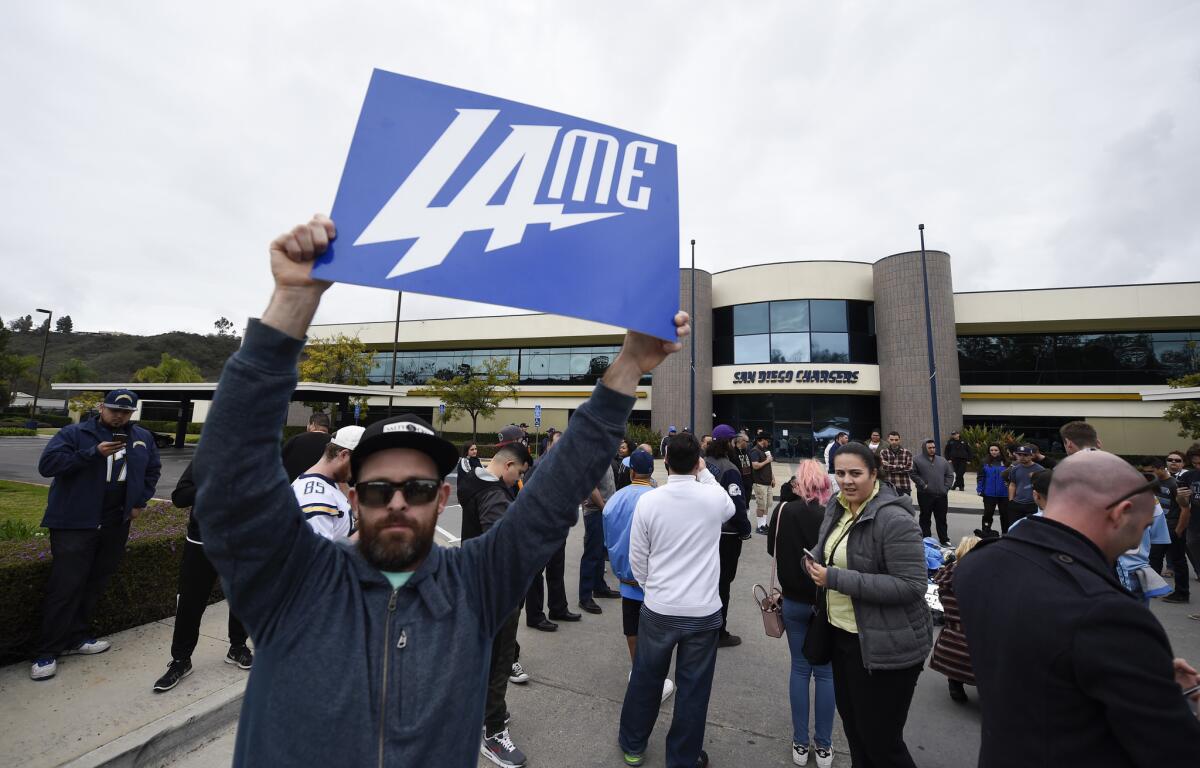Chargersâ move shows California is sick of spending public money on the NFL

The Chargersâ dramatic split from the city of San Diego may be a sign that California is officially done spending public money on sports franchises.
California voters have grown more skeptical of pouring billions of dollars into football stadiums, which have been shown to generate less of an economic boom than the National Football League has advertised. Thatâs upending the traditional relationship between billionaire franchise owners and their hometowns.
âGone are the days where there is broad public support for taxpayer-funded stadiums. Itâs very difficult to find a rate of return in that investment,â said Kristin Gaspar, who was elected as a county supervisor in San Diego in November.
After haggling with the city of San Diego for years to secure tax money to build a new stadium, and getting snubbed by voters, the Chargers announced Thursday that the team would move to Los Angeles. The team will share a privately funded new stadium in Inglewood with the Rams when it opens in 2019.
Football stadiums arenât spurring local economies, a growing body of new research shows, because theyâre used infrequently and donât offer consistent, year-round employment. The facilities are also becoming more expensive, especially over the past two decades as owners have pushed for renovations, contending that their stadiums need luxury boxes and other niceties to stay competitive.
âStadiums that used to cost $300 or $400 million, now itâs $1.2 or $1.3 billion,â said Marc Ganis, president and founder of the Chicago-based sports consulting firm SportsCorp. âThey cost more and have a shorter life cycle.â
The Chargers budgeted $1.8 billion for a new stadium and convention center annex in San Diego, and sponsored a measure asking for $1.15 billion in taxpayer funding, via a hotel tax. Voters who went to the polls in November overwhelmingly rejected that measure, 57% to 43%.
Since 2000, most of the major new stadiums in California have been built or are being planned without any direct subsidy from the public. No taxpayer money went to constructing AT&T Park, where the San Francisco Giants play; Avaya Stadium, where the San Jose Earthquakes are based; or the StubHub Center, which houses the LA Galaxy and, for the next two years, the Chargers.
Santa Clara took on only 9% of the costs of building Leviâs Stadium, the new home of the San Francisco 49ers football team that opened in 2014. And the NBAâs Golden State Warriors are privately financing the Chase Arena, set to break ground next week in San Franciscoâs Mission Bay. In many of these cases, cities chipped in either directly or through tax breaks for infrastructure surrounding the buildings.
The Sacramento Kingsâs Golden 1 Center opened in September as a notable exception to the trend; the city covered more than 40% of an estimated $556.6 million for the facility, mostly with revenue from parking. The City Council voted for the hefty subsidies after a years-long fight with Kings ownership and the NBA to keep the team from leaving Sacramento, which has no other major professional sports teams.
For decades, Angelenos went without a hometown NFL team in part because they were notoriously loath to spend taxes on one. Rams owner Stan Kroenke, worth $7.4 billion according to Forbes, made the leagueâs return to Los Angeles possible because he was game to use his own money to develop the $2.66-billion Inglewood stadium that, starting in 2019, will be home base of his team and the Chargers.
Inglewood will ultimately pay the project an estimated $60 million as a reimbursement for the development of roadwork, utilities and public parks on the site of the property.
James T. Butts Jr., mayor of Inglewood, said he would not have agreed to a new NFL stadium if it required fans to chip in.
âFrom our first talks, we made it clear that was not something we were going to do,â Butts said. âWe wanted a model that basically insulated the city from the buffeting winds of both the economy and ticket sales, and we have that now.â
But analysts say there could be a more straightforward reason that Southern Californians, rather than, say, Philadelphians, donât want to spend much on their teamsâ digs: They have more entertainment options and arenât as die-hard fans.
âI donât know that we care as much about our franchises as other cities,â said David Carter, the executive director of the Sports Business Institute at the USC Marshall School of Business. A fancy new stadium âisnât as much of a must-have as it is in some of these other cities and towns that have been willing to throw public dollars at their franchises,â he said.
Chargers fans havenât been shy about expressing their anger at the teamâs relocation, and sports business experts say they probably would vote the same way on the subsidy proposal if they had the chance to do it again. San Diegans were still bitter over Chargers owner Dean Spanosâ 2015 proposal to move the team to Carson in a privately financed stadium shared with the Raiders.
âPeople got emotional not just about spending taxpayer money but about the way he had alienated the San Diego people,â said Jim Lackritz, co-founder of the San Diego State Sports Business M.B.A. program. Thereâs a large group of voters, Lackritz said, who âIf you put a gun to their head they are going to say, âScrew it, we donât need you that bad. Go; donât let the door hit you on the way out.ââ
Whether the move to Los Angeles pays off for the Chargers remains to be seen.
Like the Rams, the Chargers are required to pay a $650-million relocation fee, to be split among owners of other NFL teams, over 10 years. But the value of the former San Diego franchise is also expected to increase dramatically in L.A., the second biggest television market in the U.S., according to analysts. The team will pay $1 a year as a tenant in the Inglewood stadium and will help finance the project with a $200-million loan from the NFL, in addition to contributing revenue generated by the sale of personal seat licenses.
The NFL has suggested that the Chargers and the Rams could each pocket 18.75% of the revenue from the naming rights for the stadium along with revenue from any other sponsorship deals. The rest of that money would go into financing the buildingâs construction.
Much has been made of Angelenosâ apathy toward the Chargers, but analysts said they donât think Spanos has done anything to permanently alienate fans, or stop them from paying for pricey tickets to watch them play in Los Angeles.
Doug Allen, the former assistant executive director of the NFL Players Assn., noted that people were skeptical when two teams from New York â the Giants and the Jets â moved to the same stadium in New Jersey more than three decades ago. But the relocation was ultimately a success, and the two teams together poured $1.3 billion into the new MetLife Stadium, which opened in 2010.
âIt hasnât been fatal for the team or the league for a franchise to move,â Allen said.
Times staff writer Samantha Masunaga contributed to this report.
Follow me @NatalieKitro on Twitter
ALSO
Shaikin: Chargersâ task to win over L.A. is like climbing âMt. Everestâ
FAA approves Inglewood stadium that Rams, Chargers will share
Chargers explained: Is Los Angeles getting a quality NFL team?
More to Read
Inside the business of entertainment
The Wide Shot brings you news, analysis and insights on everything from streaming wars to production â and what it all means for the future.
You may occasionally receive promotional content from the Los Angeles Times.











